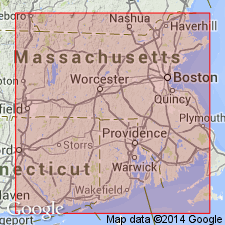
- Usage in publication:
-
- Bass Rock Member
- Modifications:
-
- Original reference
- Dominant lithology:
-
- Phyllite
- Siltstone
- AAPG geologic province:
-
- New England province
Summary:
Pg. 33-34. Bass Rock Member of Jamestown Formation of Conanicut Group (new). Transitional between the massive gray phyllites of the underlying Lion Head Member to the typical striped phyllites and siltstones of the overlying Fort Burnside Formation. [Thickness not stated.] Rocks previously mapped as basal part of Fort Burnside. [Age is Middle Cambrian, based on stratigraphic relations.]
Type locality: northwest of Beavertail fault zone and south of the Lion Head Chasm, Conanicut Island, southern Narragansett Bay, [Beavertail State Park, Narragansett Pier 7.5-min quadrangle, Newton Co.], southeastern RI. [Origin of name not stated by authors. Probably named from Bass Rock, south of Lion Head, Beavertail State Park, Narragansett Pier 7.5-min quadrangle, Newton Co., southeastern RI.]
Source: Publication.
For more information, please contact Nancy Stamm, Geologic Names Committee Secretary.
Asterisk (*) indicates published by U.S. Geological Survey authors.
"No current usage" (†) implies that a name has been abandoned or has fallen into disuse. Former usage and, if known, replacement name given in parentheses ( ).
Slash (/) indicates name conflicts with nomenclatural guidelines (CSN, 1933; ACSN, 1961, 1970; NACSN, 1983, 2005, 2021). May be explained within brackets ([ ]).

